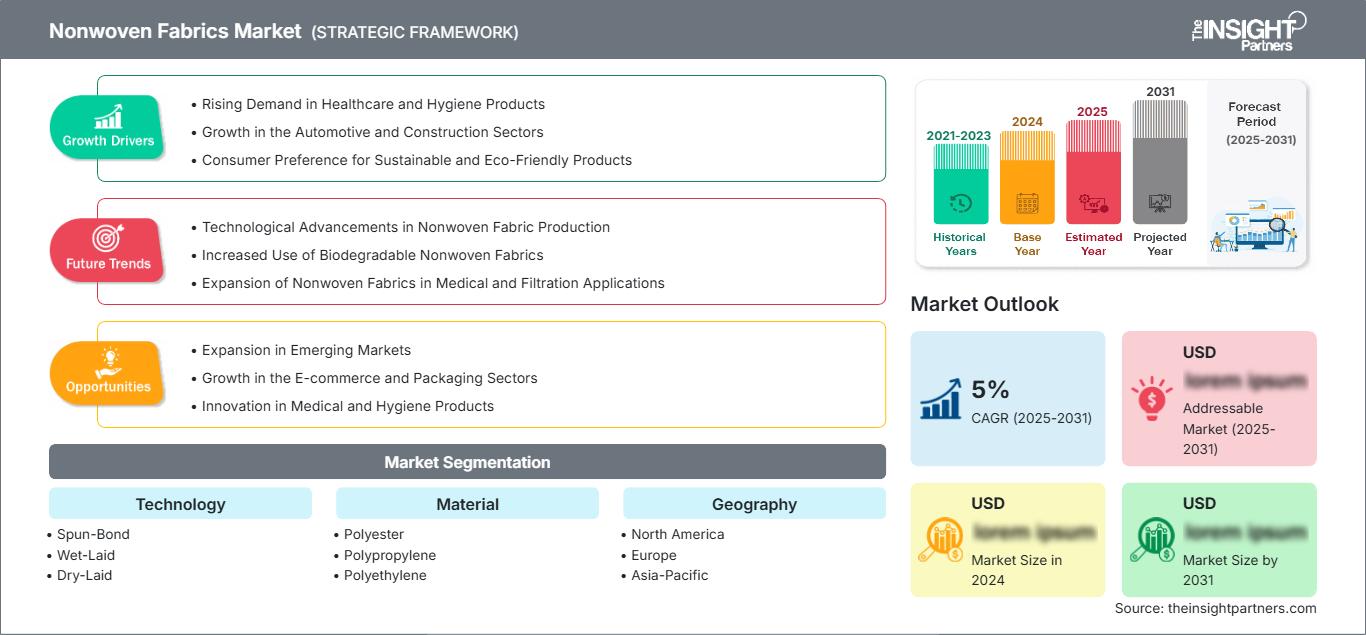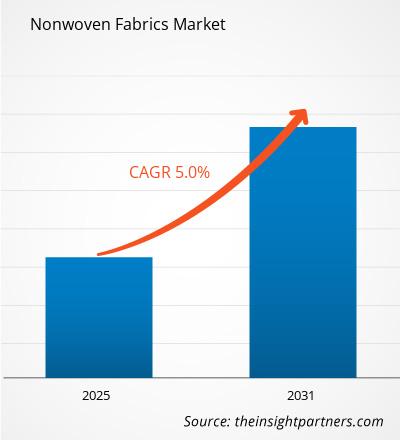不織布市場は、2025年から2031年にかけて年平均成長率(CAGR)5%で成長し、市場規模は2024年のXX百万米ドルから2031年にはXX百万米ドルに拡大すると予想されています。
不織布市場の規模と予測(2021年~2031年)、世界および各地域の成長機会分析、技術(スパンボンド、ウェットレイド、ドライレイド、その他の技術)、素材(ポリエステル、ポリプロピレン、ポリエチレン、レーヨン、その他の素材)、エンドユーザー産業(建設、繊維、ヘルスケア、自動車、その他のエンドユーザー産業)、および地理(北米、ヨーロッパ、アジア太平洋、中東およびアフリカ、南米および中米)。不織布は、従来の織物や編み物とは異なるタイプの繊維素材です。繊維やフィラメントを波打ったり編んだりするのではなく、結合したり絡ませたりすることで製造されます。不織布は、天然繊維、合成繊維、またはそれらの組み合わせで作られています。
レポートの目的
The Insight Partners による不織布市場レポートは、現在の状況と将来の成長、主な推進要因、課題、および機会を説明することを目的としています。これにより、次のようなさまざまなビジネス関係者に洞察が提供されます。
- 技術プロバイダー/メーカー: 進化する市場動向を理解し、潜在的な成長機会を把握することで、情報に基づいた戦略的意思決定を行うことができます。
- 投資家: 市場の成長率、市場の財務予測、およびバリュー チェーン全体に存在する機会に関する包括的なトレンド分析を実施します。
- 規制機関: 市場の乱用を最小限に抑え、投資家の信頼と信用を維持し、市場の完全性と安定性を維持することを目的として、市場における政策と警察活動を規制します。
不織布市場セグメンテーション技術
- スパンボンド
- ウェットレイド
- ドライレイド
- その他の技術
素材
- ポリエステル
- ポリプロピレン
- ポリエチレン
- レーヨン
- その他の素材
レポートの一部、国レベルの分析、Excelデータパックなどを含め、スタートアップ&大学向けに特別オファーや割引もご利用いただけます(無償)
不織布市場: 戦略的洞察

- このレポートの主要な市場動向を入手してください。この無料サンプルには、市場動向から見積もりや予測に至るまでのデータ分析が含まれます。
不織布市場の成長ドライバー
- ヘルスケアおよび衛生製品の需要増加:ヘルスケアおよび衛生分野は、不織布市場の成長を牽引する主要な要因です。不織布は、サージカルマスク、ガウン、おむつ、生理用ナプキン、創傷ケア製品などの製品に一般的に使用されています。世界的な衛生意識の高まりと、COVID-19パンデミックによる個人用保護具(PPE)の需要急増により、ヘルスケア用途の不織布市場は大幅に拡大しました。ヘルスケア業界が成長・進化を続けるにつれて、不織布の需要も高まります。
- 自動車および建設分野の成長:自動車および建設業界は、不織布の需要に貢献する主要な分野です。自動車業界では、不織布は車内装飾、断熱材、フィルター、防音材など、さまざまな用途に使用されています。同様に、建設業界では、不織布はジオテキスタイル、屋根材、断熱材に使用されています。都市化、インフラ整備、自動車生産の増加に伴い、これらの業界は不織布の需要を継続的に押し上げています。
- 持続可能で環境に優しい製品に対する消費者の嗜好:持続可能で環境に優しい製品への移行が進み、天然素材や生分解性素材から作られた不織布の需要が高まっています。環境への責任を優先する消費者や業界が増えるにつれ、不織布、特に竹、綿、リサイクルPETなどの持続可能な繊維から作られた不織布が注目を集めています。廃棄物の削減と、包装、衣類、その他の消費財におけるリサイクル可能な素材の採用への重点が、この需要を促進しています。
不織布市場の将来の動向
- 不織布生産における技術の進歩:重要な技術革新により不織布の生産が強化され、性能と効率が向上しています。スパンボンド、メルトブローン、ニードルパンチングなどの新しい製造技術により、強度、耐久性、耐水性が向上した布地が生まれました。これらの進歩により、不織布の潜在的な用途が拡大し、自動車、衛生、建設など、さまざまな業界にとってより魅力的なものとなっています。
- 生分解性不織布の使用増加:環境への懸念が高まる中、生分解性不織布の生産と使用に向けた顕著な傾向が見られます。これらの布地は、黄麻、麻、綿などの天然繊維やバイオポリマーから作られており、合成不織布に代わる環境に優しい代替品を提供しています。プラスチック廃棄物と二酸化炭素排出量を削減するための世界的な取り組みと足並みを揃え、不織布生産における持続可能性への移行がますます進んでいます。
- 医療・ろ過用途における不織布の拡大:サージカルマスク、創傷ケア製品、医療用ガウンなど、医療用途における不織布の需要は、特にCOVID-19パンデミックへの対応として急増しています。さらに、不織布は高いろ過効率から、空気ろ過製品や水ろ過製品にもますます多く使用されています。ヘルスケア分野における衛生・保護製品向け不織布への依存度の高まり、そして環境への懸念の高まりにより、より優れたろ過ソリューションの必要性が高まっていることも、この傾向を後押ししています。
不織布市場の機会
- 新興市場における拡大:新興経済国、特にアジア太平洋、ラテンアメリカ、アフリカは、不織布メーカーにとって大きな成長機会を提供しています。これらの地域では、工業化、都市化、可処分所得の増加が見られ、ヘルスケア、衛生、自動車、建設などの分野で不織布の需要が増加すると予想されます。メーカーは、これらの地域における中流階級の増加と、近代的なインフラおよび消費財への高まる需要を活用できます。
- Eコマースおよび包装セクターの成長:Eコマースの急速な成長に伴い、持続可能で保護的な包装材料の需要が高まっています。不織布は、軽量で耐久性があり、環境に優しい特性があるため、包装用途での使用に大きな可能性を秘めています。不織布を使用した革新的な包装ソリューションの開発に注力する企業は、持続可能な包装の代替品へと移行しつつある拡大するEコマースおよび小売市場に参入することができます。
- 医療および衛生製品におけるイノベーション:医療および衛生業界は、不織布メーカーにとって大きなチャンスを提供しています。特にパンデミックなどの健康危機への対応として、世界的なヘルスケアニーズの高まりが、医療用使い捨て製品、PPE、衛生製品における不織布の需要を促進しています。抗菌性や強化された液体バリア機能などの医療用不織布のイノベーションは、さらなる成長の可能性を秘めています。さらに、世界的に衛生・生理用品への注目が高まっているため、おむつ、女性用衛生用品、成人用失禁用品に使用される高度な不織布素材に対する需要が継続的に高まっています。
不織布市場の地域別分析
The Insight Partnersのアナリストは、予測期間を通じて不織布市場に影響を与える地域的な動向と要因を詳細に解説しています。このセクションでは、北米、ヨーロッパ、アジア太平洋、中東・アフリカ、中南米における不織布市場のセグメントと地域についても解説しています。
不織布市場レポートの範囲
| レポート属性 | 詳細 |
|---|---|
| の市場規模 2024 | US$ XX million |
| 市場規模別 2031 | US$ XX Million |
| 世界的なCAGR (2025 - 2031) | 5% |
| 過去データ | 2021-2023 |
| 予測期間 | 2025-2031 |
| 対象セグメント |
By 技術
|
| 対象地域と国 | 北米
|
| 市場リーダーと主要企業の概要 |
|
不織布市場のプレーヤーの密度:ビジネスダイナミクスへの影響を理解する
不織布市場は、消費者の嗜好の変化、技術の進歩、製品の利点に対する認知度の高まりといった要因によるエンドユーザーの需要増加に牽引され、急速に成長しています。需要の増加に伴い、企業は製品ラインナップの拡充、消費者ニーズへの対応のための革新、そして新たなトレンドの活用を進めており、これが市場の成長をさらに加速させています。

- 入手 不織布市場 主要プレーヤーの概要
主なセールスポイント
- 包括的な調査範囲:本レポートは、不織布市場の製品、サービス、種類、エンドユーザーの分析を包括的に網羅し、包括的な展望を提供しています。
- 専門家による分析:本レポートは、業界の専門家とアナリストの深い理解に基づいて作成されています。
- 最新情報:本レポートは、最新の情報とデータ動向を網羅しているため、ビジネスの関連性を保証します。
- カスタマイズオプション:本レポートは、特定のクライアントの要件に対応し、ビジネス戦略に適切に適合するようにカスタマイズできます。
したがって、不織布市場に関する調査レポートは、業界のシナリオと成長見通しを解読し理解するための先導役となります。いくつかの正当な懸念事項があるかもしれませんが、本レポートの全体的なメリットは、デメリットを上回る傾向があります。
- 過去2年間の分析、基準年、CAGRによる予測(7年間)
- PEST分析とSWOT分析
- 市場規模価値/数量 - 世界、地域、国
- 業界と競争環境
- Excel データセット
最新レポート
お客様の声
購入理由
- 情報に基づいた意思決定
- 市場動向の理解
- 競合分析
- 顧客インサイト
- 市場予測
- リスク軽減
- 戦略計画
- 投資の正当性
- 新興市場の特定
- マーケティング戦略の強化
- 業務効率の向上
- 規制動向への対応




















 無料サンプルを入手 - 不織布市場
無料サンプルを入手 - 不織布市場